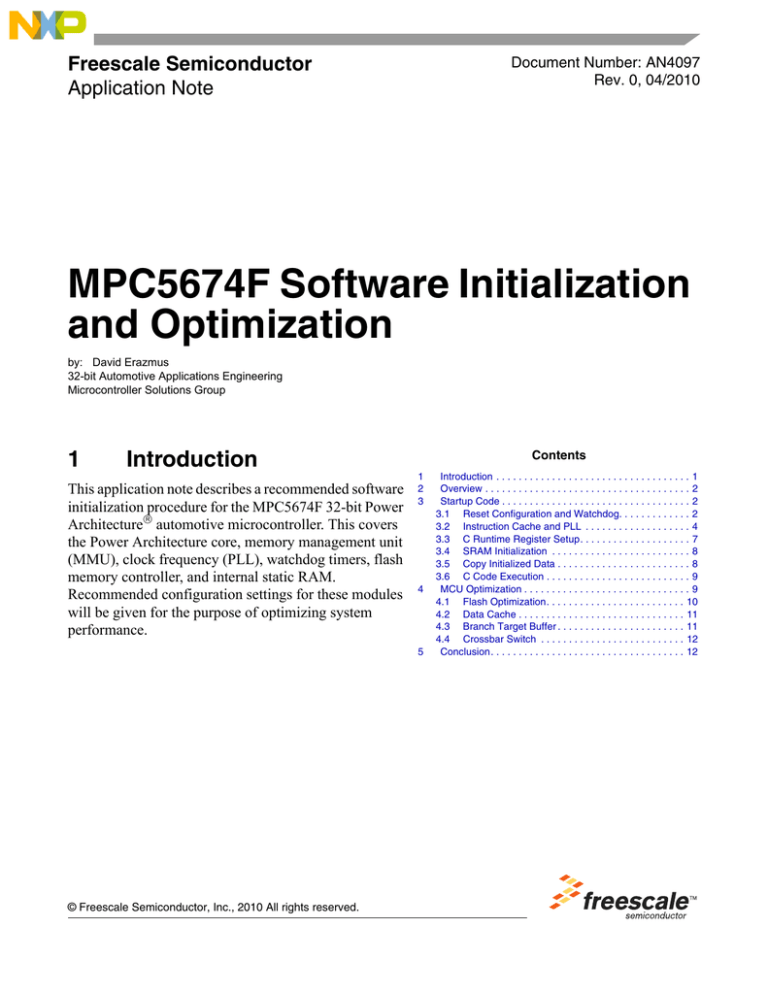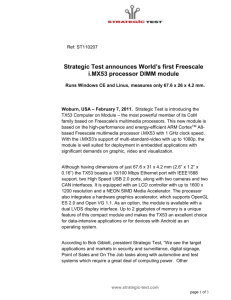
Freescale Semiconductor
Application Note
Document Number: AN4097
Rev. 0, 04/2010
MPC5674F Software Initialization
and Optimization
by: David Erazmus
32-bit Automotive Applications Engineering
Microcontroller Solutions Group
1
Introduction
This application note describes a recommended software
initialization procedure for the MPC5674F 32-bit Power
Architecture® automotive microcontroller. This covers
the Power Architecture core, memory management unit
(MMU), clock frequency (PLL), watchdog timers, flash
memory controller, and internal static RAM.
Recommended configuration settings for these modules
will be given for the purpose of optimizing system
performance.
Contents
1
2
3
4
5
© Freescale Semiconductor, Inc., 2010 All rights reserved.
Introduction . . . . . . . . . . . . . . . . . . . . . . . . . . . . . . . . . . . 1
Overview . . . . . . . . . . . . . . . . . . . . . . . . . . . . . . . . . . . . . 2
Startup Code . . . . . . . . . . . . . . . . . . . . . . . . . . . . . . . . . . 2
3.1 Reset Configuration and Watchdog. . . . . . . . . . . . . 2
3.2 Instruction Cache and PLL . . . . . . . . . . . . . . . . . . . 4
3.3 C Runtime Register Setup. . . . . . . . . . . . . . . . . . . . 7
3.4 SRAM Initialization . . . . . . . . . . . . . . . . . . . . . . . . . 8
3.5 Copy Initialized Data . . . . . . . . . . . . . . . . . . . . . . . . 8
3.6 C Code Execution . . . . . . . . . . . . . . . . . . . . . . . . . . 9
MCU Optimization . . . . . . . . . . . . . . . . . . . . . . . . . . . . . . 9
4.1 Flash Optimization. . . . . . . . . . . . . . . . . . . . . . . . . 10
4.2 Data Cache . . . . . . . . . . . . . . . . . . . . . . . . . . . . . . 11
4.3 Branch Target Buffer . . . . . . . . . . . . . . . . . . . . . . . 11
4.4 Crossbar Switch . . . . . . . . . . . . . . . . . . . . . . . . . . 12
Conclusion. . . . . . . . . . . . . . . . . . . . . . . . . . . . . . . . . . . 12
Overview
2
Overview
There are several options to consider when discussing the structure of our embedded software application.
The first is how it will execute. The application can be stored in internal flash memory or it can be
downloaded from an external device such as a debugger or via a serial communications link. This affects
certain steps in the initialization process and where applicable, this will be noted. Another option is
choosing Variable Length Encoding instructions (VLE) vs. PowerPC BookE Instructions. The assembly
code examples shown in this application note will be using VLE mnemonics and syntax but can easily be
translated into the BookE variant.
3
Startup Code
The first part of our initialization procedure executes from the reset vector or program entry point and
performs the minimal setup needed to prepare for C code execution later on. Another goal of this stage is
to optimize the startup procedure’s execution time. This involves taking certain initialization steps in a
particular order:
1. Reset Configuration and Watchdog
2. Enable Cache
3. Program PLL
4. Initialize SRAM
5. Initialize C Runtime Environment
3.1
Reset Configuration and Watchdog
There are several ways to begin software execution after device reset. These are controlled by the Boot
Assist Module (BAM).
• Boot from internal flash
• Serial boot via SCI or CAN interface with optional baud-rate detection
• Boot from a memory connected to the MCU development bus (EBI) with multiplexed or separate
address and data lines (not available on all packages)
When using a hardware debugger connected via the JTAG or Nexus ports, the BAM can be bypassed if
desired. The debugger can download software to RAM via the debug interface and specify a start location
for execution. In this case, much of the low-level device initialization is typically accomplished by the
debugger using configuration scripts.
We will focus on the internal flash boot case in this application note since it performs all initialization tasks
either in the BAM or explicitly in the application code. During any power-on, external, or internal reset
event except for software reset the BAM begins by searching for a valid Reset Configuration Half Word
(RCHW) in internal flash memory at one of the following pre-defined addresses.
MPC5674F Software Initialization and Optimization, Rev. 0
2
Freescale Semiconductor
Startup Code
Table 1. Possible RCHW Locations in the Internal Flash
Block
Address
0
0x0000_0000
1
0x0000_4000
2
0x0001_0000
3
0x0001_C000
4
0x0002_0000
5
0x0003_0000
The RCHW is a collection of control bits that specify a minimal MCU configuration after reset. If a valid
RCHW is not found, the BAM will attempt a serial boot. Here is the format for the RCHW:
Table 2. Reset Configuration Half Word
0
1
2
3
4
SWT
5
6
7
WTE
PS0
VLE
8
0
9
1
10
0
11
1
12
1
13
0
14
1
15
0
Boot Identifier = 0x5A
The RCHW occupies the most significant 16 bits of the first 32-bit internal memory word at the boot
location. The word immediately following this contains the boot vector address. After applying the
RCHW, the BAM will branch to this address. During software initialization we can reserve space for both
of these 32-bit locations in the linker directive file as follows:
MEMORY
{
flash_rcw : org = FLASH_BASE_ADDR,
…
}
SECTIONS
{
.rcw
…
}
len = 0x8
: {} > flash_rcw
In the initialization code file, these two locations is generated with a valid RCHW encoding and the start
address symbol for code entry point.
.section .rcw
.LONG 0x015A0000
.LONG _start
# RCHW
# Code entry point
In the above example, the core and software watchdog timers are both disabled. These can both operate
independently, but it is typical to use just one or the other in an application. When debugging, the RCHW
is not applied as the BAM does not execute, so it is up to the debugger to disable these timers so that they
do not interfere with application debug sessions. This is necessary for the core watchdog as software
cannot be disabled it once it is enabled. The software watchdog starts out in an unlocked state, so the
control register is still writable. If desired, the enable bit can be cleared, to prevent watchdog operation
during a debug session if the debug tool does not handle this with its own configuration scripts.
MPC5674F Software Initialization and Optimization, Rev. 0
Freescale Semiconductor
3
Startup Code
NOTE
If either watchdog timer is enabled there may be points within the
initialization procedure that require watchdog service depending on the
timeout period of the watchdog.
3.2
Instruction Cache and PLL
Enabling the instruction cache will reduce execution time for the remainder of the initialization procedure
and, of course, improve application execution speed later on. Enabling the cache after the PLL is
programmed, can increase peak current draw during the setup routine, so it is recommended that the cache
be enabled first. However, when we are executing code from internal flash it is also a good idea to inhibit
the flash space, initially, until after PLL programming. The reason for this is the polling loop that tests for
PLL lock. With the cache enabled this loop can execute very quickly and draw more current. There is not
a real need for the polling loop to execute that quickly at this point, so the Memory Management Unit will
be used to first inhibit the flash region from caching and then enable the cache.
3.2.1
Memory Management Unit
The BAM includes a default setup for the MMU which allows access to all device internal resources with
no address translation. Variable Length Encoding (VLE) for instructions will be enabled for SRAM and
Flash regions if enabled in the RCHW. This default configuration may be sufficient for most applications
but as mentioned above one change is made to inhibit caching in the flash until after PLL lock. By default,
the BAM sets up MMU table index 1 for the internal flash region with a size of 16MB. The cache-inhibit
control bit is set and during this, reduce the size to 4MB to cover just the user flash region for this device.
# Set
#
#
#
#
up MMU
MAS0 :
MAS1 :
MAS2 :
MAS3 :
ESEL=1
TSIZ=4Mbytes
EPN=0x000000028, VLE=1, W=0, I=1, M=0, G=0, E=big
RPN=0x000000000, PERMIS=all
e_lis
mtspr
r3,0x1001
mas0,r3
e_lis
e_or2i
mtspr
r4,0xC000
r4,0x0600
mas1,r4
e_lis
e_or2i
mtspr
r5,0x0000
r5,0x0028
mas2,r5
e_lis
e_or2i
mtspr
r6,0x0000
r6,0x003f
mas3,r6
msync
tlbwe
se_isync
# Synchronize for running out of flash
# Synchronize for running out of flash
MPC5674F Software Initialization and Optimization, Rev. 0
4
Freescale Semiconductor
Startup Code
Note that in this example, tlbwe is preceded by msync and followed by isync. These synchronization steps
are taken when we are executing code from the region being modified.
3.2.2
Enable Cache
The core instruction and data caches are enabled through the L1 Cache Control and Status Registers 1 &
2 (L1CSR0 and L1CSR1). At this point just the instruction cache is enabled since nothing is being done
in the initialization routines that would benefit from data cache yet. The instruction cache is invalidated
and enabled by setting the ICINV and ICE bits in L1CSR1. The cache invalidate operation takes some time
and can be interrupted or aborted. Since nothing else is going on at this point in the boot-up procedure this
is not going to happen here and we could just get by setting these bits and moving on. For future reference,
however, the code shown here represents a more robust cache enable routine that may be used elsewhere
in the application, if desired. This code checks to ensure the invalidation has successfully completed and
if not, retries the operation before enabling the cache.
cfg_ICACHE:
#--------------------------------------------#
# Invalidate Instruction Cache - Set ICINV
#
# bit in L1CSR1 Register
#
#--------------------------------------------#
e_lis
r5, 0x0000
e_or2i r5, 0x0002
mtspr l1csr1,r5
#--------------------------------------------#
# Mask out ICINV and ICABT to see if
#
# invalidation is complete (i.e. ICINV=0,
#
# ICABT=0)
#
#--------------------------------------------#
label_ICINV_check:
#--------------------------------------------#
# Load Registers with Masks:
#
# Load ICINV mask into R4
#
# Load ICABT mask into R6
#
# Load ICABT clear mask into R7
#
#--------------------------------------------#
e_lis
r4, 0x0000
e_or2i r4, 0x0002
e_lis
r6, 0x0000
e_or2i r6, 0x0004
e_lis
r7, 0xFFFF
e_or2i r7, 0xFFFB
CHECK_ICINV:
#--------------------------------------------#
# Read L1CSR1 register, store in r3
#
#--------------------------------------------#
mfspr r3, l1csr1
#--------------------------------------------#
# check for an ABORT of the cache invalidate #
# operation
#
#--------------------------------------------#
se_and. r6, r3
MPC5674F Software Initialization and Optimization, Rev. 0
Freescale Semiconductor
5
Startup Code
e_beq
NO_ABORT
#--------------------------------------------#
# If abort detected, clear ICABT bit and
#
# re-run invalidation
#
#--------------------------------------------#
se_and. r7, r3
mtspr l1csr1, r10
se_b
cfg_ICACHE
NO_ABORT:
#--------------------------------------------#
# Check that invalidation has completed #
# (ICINV=0). Branch if invalidation not
#
# complete.
#
#--------------------------------------------#
se_and. r4, r3
e_bne
CHECK_ICINV
#--------------------------------------------#
# Enable cache the ICache by performing a
#
# read/modify/write of the ICE bit in the
#
# L1CSR1 register
#
#--------------------------------------------#
mfspr r5, l1csr1
e_or2is r5, 0x0000
e_or2i r5, 0x0001
# Store L1CSR1 value to R5 (ICE=1)
se_isync
msync
mtspr l1csr1, r5
# Write R5 to L1CSR1 register
se_blr
3.2.3
Programming the PLL
The FMPLL module contains the frequency modulated phase lock loop (FMPLL), enhanced frequency
divider (ERFD), enhanced synthesizer control registers (ESYNCR1 and ESYNCR2), synthesizer status
register (SYNSR), and clock/PLL control logic. The block also contains a reference frequency pre-divider
controlled by the EPREDIV bits in the ESYNCR1. This enables the use of a high frequency crystal or
external clock generator to obtain finer frequency synthesis resolution than would be available if the raw
input clock were used directly by the analog loop.
The FMPLL on this device can synthesize clock frequencies ranging from 48 to 148 times the reference
frequency of the predivider output. The post-divider can reduce this output frequency without forcing a
re-lock. In normal operation, the following equation can be used to calculate the programming values for
the FMPLL:
Fsys = Fextal x (EMFD + 16) / ((EPREDIV + 1)(EFRD + 1))
Eqn. 1
The following example sets up the PLL to produce a 264MHz system clock assuming a 40MHz reference
crystal.
# ESYNCR1
e_lis
e_lis
r3, 0xC3F8
r4, 0x0004
# EPREDIV
MPC5674F Software Initialization and Optimization, Rev. 0
6
Freescale Semiconductor
Startup Code
e_or2i
e_stw
r4, 0x0032
r4, 8(r3)
# ESYNCR2
e_lis
e_or2i
e_stw
r4, 0x0000
r4, 0x0001
r4, 12(r3)
wait_for_lock:
e_lwz
r5, 4(r3)
e_andi. r5, r5, 0x8
beq wait_for_lock
# EMFD
# ERFD
# load SYNSR
Now that we’ve locked on our new clock rate, we can enable caching for the flash region.
#
#
#
#
#
Enable
MAS0 :
MAS1 :
MAS2 :
MAS3 :
e_lis
mtspr
r3,0x1001
mas0,r3
e_lis
e_or2i
mtspr
r4,0xC000
r4,0x0600
mas1,r4
e_lis
e_or2i
mtspr
r5,0x0000
r5,0x0020
mas2,r5
e_lis
e_or2i
mtspr
r6,0x0000
r6,0x003f
mas3,r6
msync
tlbwe
se_isync
3.3
caching of this region
ESEL=1
TSIZ=4Mbytes
EPN=0x000000020, VLE=1, W=0, I=0, M=0, G=0, E=big
RPN=0x000000000, PERMIS=all
# Synchronize for running out of flash
# Synchronize for running out of flash
C Runtime Register Setup
The Power Architecture Enhanced Application Binary Interface (EABI) specifies certain general purpose
registers as having special meaning for C code execution. In the initialization code at this point the stack
pointer, small data, and small data 2 base pointers are set up. EABI-conformant C compilers will generate
code that makes use of these pointers later on.
e_lis
e_or2i
r1, __SP_INIT@h
r1, __SP_INIT@l
# Initialize stack pointer r1 to
# value in linker command file.
e_lis
e_or2i
r13, _SDA_BASE_@h
r13, _SDA_BASE_@l
# Initialize r13 to sdata base
# (provided by linker).
e_lis
e_or2i
r2, _SDA2_BASE_@h
r2, _SDA2_BASE_@l
# Initialize r2 to sdata2 base
# (provided by linker).
As noted in the comments above, these values are defined in the linker command file for our project.
MPC5674F Software Initialization and Optimization, Rev. 0
Freescale Semiconductor
7
Startup Code
__DATA_SRAM_ADDR = ADDR(.data);
__SDATA_SRAM_ADDR = ADDR(.sdata);
__DATA_SIZE
__SDATA_SIZE
= SIZEOF(.data);
= SIZEOF(.sdata);
__DATA_ROM_ADDR = ADDR(.ROM.data);
__SDATA_ROM_ADDR = ADDR(.ROM.sdata);
The values in the internal flash boot case will be used to copy initialized data from flash to SRAM, but
first the SRAM must be initialized.
3.4
SRAM Initialization
The internal SRAM features Error Correcting Code (ECC). Because these ECC bits can contain random
data after the device is powered on, all SRAM locations must be initialized before being read by
application code. This is done by executing 64-bit writes to the entire SRAM block. The value written does
not matter at this point, so the Store Multiple Word instruction will be used to write 32 general-purpose
registers at a time.
# Store number of 128Byte (32GPRs) segments in Counter
e_lis
r5, _SRAM_SIZE@h
# Initialize r5 to size of SRAM (Bytes)
e_or2i
r5, _SRAM_SIZE@l
e_srwi
r5, r5, 0x7
# Divide SRAM size by 128
mtctr
r5
# Move to counter for use with "bdnz"
# Base Address of the internal SRAM
e_lis
r5, _SRAM_BASE_ADDR@h
e_or2i
r5, _SRAM_BASE_ADDR@l
# Fill SRAM with writes of 32GPRs
sram_loop:
e_stmw
r0,0(r5)
e_addi
r5,r5,128
e_bdnz
sram_loop
3.5
# Write all 32 registers to SRAM
# Increment the RAM pointer to next 128bytes
# Loop for all of SRAM
Copy Initialized Data
When booting from flash, the program image stored in flash will contain the various data segments created
by the C compiler and linker. Initialized read-write data must be copied from read-only flash to
read-writable SRAM before we branch to our C main routine.
##--------- Initialized Data - ".data" -------------------------------------DATACOPY:
e_lis
r9, __DATA_SIZE@ha
# Load upper SRAM load size
e_or2i
r9, __DATA_SIZE@l
# Load lower SRAM load size into R9
e_cmp16i
r9,0
# Compare to see if equal to 0
e_beq
SDATACOPY
# Exit cfg_ROMCPY if size is zero
mtctr
r9
# Store no. of bytes to be moved in counter
e_lis
e_or2i
e_subi
r10, __DATA_ROM_ADDR@h
r10, __DATA_ROM_ADDR@l
r10,r10, 1
# Load address of first SRAM load into R10
# Load lower address of SRAM load into R10
# Decrement address
e_lis
r5, __DATA_SRAM_ADDR@h
# Load upper SRAM address into R5
MPC5674F Software Initialization and Optimization, Rev. 0
8
Freescale Semiconductor
MCU Optimization
e_or2i
e_subi
DATACPYLOOP:
e_lbzu
e_stbu
e_bdnz
r5, __DATA_SRAM_ADDR@l
r5, r5, 1
r4, 1(r10)
r4, 1(r5)
DATACPYLOOP
# Load lower SRAM address into R5
# Decrement address
# Load data byte at R10 into R4
# Store R4 data byte into SRAM at R5
# Branch if more bytes to load from ROM
##--------- Small Initialised Data - ".sdata" -------------------------------------SDATACOPY:
e_lis
r9, __SDATA_SIZE@ha
# Load upper SRAM load size
e_or2i
r9, __SDATA_SIZE@l
# Load lower SRAM load size into R9
e_cmp16i
r9,0
# Compare to see if equal to 0
e_beq
ROMCPYEND
# Exit cfg_ROMCPY if size is zero
mtctr
r9
# Store no. of bytes to be moved in counter
e_lis
e_or2i
e_subi
r10, __SDATA_ROM_ADDR@h # Load address of first SRAM load into R10
r10, __SDATA_ROM_ADDR@l # Load lower address of SRAM load into R10
r10,r10, 1
# Decrement address
e_lis
r5, __SDATA_SRAM_ADDR@h # Load upper SRAM address into R5
e_or2i
r5, __SDATA_SRAM_ADDR@l # Load lower SRAM address into R5
e_subi
r5, r5, 1
# Decrement address
SDATACPYLOOP:
e_lbzu
r4, 1(r10)
# Load data byte at R10 into R4
e_stbu
r4, 1(r5)
# Store R4 data byte into SRAM at R5
e_bdnz
SDATACPYLOOP
# Branch if more bytes to load from ROM
ROMCPYEND:
##---------------------------------------------------------------------------
3.6
C Code Execution
At this point in the procedure C code execution can be started. Before branching to our application main
routine, however, there are some additional microcontroller setup and optimization steps to perform. These
are described in the next sections.
##--------- Start of Main Code----------------------------------------------# Start of MCU initialization code
e_bl
init_MCU
# Start of optimisation code
e_bl
optimise_MCU
# Start of main code
e_bl
main
##---------------------------------------------------------------------------
4
MCU Optimization
In this section, the following areas for potential optimization will be discussed:
• Wait states, prefetch, and BIU settings for the flash controller
• Data Cache
• Branch Target Buffer
• Crossbar Switch
MPC5674F Software Initialization and Optimization, Rev. 0
Freescale Semiconductor
9
MCU Optimization
4.1
Flash Optimization
The on-chip flash array controller comes out of reset with fail-safe settings. Wait states are set to maximum
and performance features like prefetch, read buffering, and pipelining are disabled. These settings can
typically be optimized based on the operating frequency using the information specified in the MPC5674F
data sheet. The following code can be modified to select the appropriate value for the flash array’s Bus
Interface Unit Control Register (BIUCR).
The example below selects the 264MHz operating settings which accomplish the following optimizations:
• Enable instruction prefetch for all masters on buffer hits and misses
• Enable read buffer
• Reduce read wait states to 3
• Enable pipelining with 3 hold cycles between access requests
• Reduce write wait states to 1
cfg_FLASH:
#--------------------------------------------#
# Save Link Register as this will be modified#
#--------------------------------------------#
mflr r3
#--------------------------------------------#
# Load Flash BIUCR Setting into R7
#
##############################################
## CHANGE FOR DIFFERENT Fsys/Fplat:
##
## Up to 264MHz/132MHz : 0x01716B15
##
## Up to 200MHz/100MHz : 0x01714A15
##
## Up to 180MHz/90MHz : 0x01714A15
##
## Up to 132MHz/132MHz : 0x01716B15
##
##############################################
#--------------------------------------------#
e_lis
r7, 0x0171
e_or2i r7, 0x6B15
#--------------------------------------------#
# Load Flash BIUCR Address into R6
#
#--------------------------------------------#
e_lis
r6, 0xC3F8
e_or2i r6, 0x801C
Since in this example we are executing from flash memory, we need to load instructions to perform the
update of BIUCR into SRAM and then execute from there temporarily.
If desired, SIU_SYSDIV[IPCLKDIV] can also be changed here to affect the platform/peripheral
frequency at which the flash array operates. This should be done before changing BIUCR settings. The
resulting flash clock rate should be checked against the MPC5674F data sheet to determine appropriate
BIUCR values. Here, the example assumes the default divider of 2, so the system clock is 264MHz and
the platform clock is 132MHz.
SRAMLOAD:
#--------------------------------------------#
# Load BIUCR write instruction into R8, R9 & #
# R10
#--------------------------------------------#
e_lis
r8, 0x54E6
#
MPC5674F Software Initialization and Optimization, Rev. 0
10
Freescale Semiconductor
MCU Optimization
e_or2i
e_lis
e_or2i
e_lis
e_or2i
r8, 0x0000
r9, 0x4C00
r9, 0x012C
r10, 0x0004
r10, 0x0004
# R8 = "e_stw r7, 0x0(r6)"
# R9 = "isync"
# R10 = ""se_blr,se_blr"
#--------------------------------------------#
# Load RAM address into R11
#
#--------------------------------------------#
e_lis
r11, _BIUCR_RAM_ADDR@h
e_add16i r11,r11, _BIUCR_RAM_ADDR@l
#--------------------------------------------#
# Store Instructions in RAM, then branch and #
# execute instructions to setup BIUCR
#
#--------------------------------------------#
e_stw
r8, 0x0(r11);
e_stw
r9, 0x4(r11);
e_stw
r10, 0x8(r11);
mtlr r11
se_blrl
NOTE
These settings are currently preliminary and subject to change pending
characterization of the device.
4.2
Data Cache
Earlier the instruction cache was enabled to speed up execution of the initialization procedure. Before the
user application is executed, the data cache will be enabled. The procedure for this is more or less the same
as for the instruction cache, taking care to ensure the invalidate operation does not abort. One additional
step is selecting the cache write mode (DCWM). When set to write-through mode, the “W” page attribute
from the MMU is ignored and all write accesses write through the cache. When set to copy-back mode,
write accesses only write through the cache for MMU regions marked with the “W” page attribute.
Otherwise the write data is stored in the cache and remains there until that cache line is flushed to memory.
Copy-back mode is generally recommended for performance, however care must be taken when sharing
data buffers between CPU, DMA, and peripherals. Write-through mode will eliminate coherency issues
when writing data from the CPU to these shared buffers, but would still require invalidation of the buffer’s
addresses from the CPU’s data cache when accepting data back from DMA or peripheral modules. The
MMU can be used to create a region of write-through or cache-inhibited space for such shared memory
needs.
4.3
Branch Target Buffer
MPC5674F Power Architecture core features a branch prediction optimization which can be enabled to
improve overall performance by storing the results of branches and using that to predict the direction of
future branches at the same location. To initialize it, we need to flash invalidate the buffer and enable
branch prediction. This can be accomplished with a single write to the Branch Unit Control and Status
Register (BUCSR) in the core.
cfg_BTB:
MPC5674F Software Initialization and Optimization, Rev. 0
Freescale Semiconductor
11
Conclusion
#--------------------------------------------#
# Flush and Enable BTB - Set BBFI and BPEN
#
#--------------------------------------------#
e_lis
r3, 0x0
e_or2i r3, 0x0201
mtspr 1013, r3
NOTE
If the application modifies instruction code in memory after this
initialization procedure, the Branch Target Buffer may need to be flushed
and re-initialized as it may contain branch prediction for the code that
previously existed at the modified locations.
4.4
Crossbar Switch
For the most part, the crossbar settings can be left at their reset defaults. It is possible, knowing certain
things about the application behavior and use of different masters on the crossbar, to customize priorities
and using algorithms accordingly and obtain some slight performance improvements. For example, DMA
transfers may benefit from a higher priority setting than the CPU load/store when communicating with the
peripheral bus. This would prevent DMA transfers from stalling if the CPU were to poll a status register
in a peripheral. Again, however, this is a specific case which may not apply for all applications.
5
Conclusion
This application note has presented some specific recommendations for initializing this device and
optimizing some of the settings from their reset defaults. This is a starting point only. Other areas to look
at include compiler optimization and efficient use of system resources such as DMA and cache. Consult
the MPC5674F reference manual for additional information.
MPC5674F Software Initialization and Optimization, Rev. 0
12
Freescale Semiconductor
How to Reach Us:
Home Page:
www.freescale.com
Web Support:
http://www.freescale.com/support
USA/Europe or Locations Not Listed:
Freescale Semiconductor, Inc.
Technical Information Center, EL516
2100 East Elliot Road
Tempe, Arizona 85284
+1-800-521-6274 or +1-480-768-2130
www.freescale.com/support
Europe, Middle East, and Africa:
Freescale Halbleiter Deutschland GmbH
Technical Information Center
Schatzbogen 7
81829 Muenchen, Germany
+44 1296 380 456 (English)
+46 8 52200080 (English)
+49 89 92103 559 (German)
+33 1 69 35 48 48 (French)
www.freescale.com/support
Japan:
Freescale Semiconductor Japan Ltd.
Headquarters
ARCO Tower 15F
1-8-1, Shimo-Meguro, Meguro-ku,
Tokyo 153-0064
Japan
0120 191014 or +81 3 5437 9125
support.japan@freescale.com
Asia/Pacific:
Freescale Semiconductor China Ltd.
Exchange Building 23F
No. 118 Jianguo Road
Chaoyang District
Beijing 100022
China
+86 10 5879 8000
support.asia@freescale.com
For Literature Requests Only:
Freescale Semiconductor Literature Distribution Center
1-800-441-2447 or 303-675-2140
Fax: 303-675-2150
LDCForFreescaleSemiconductor@hibbertgroup.com
Document Number: AN4097
Rev. 0
04/2010
Information in this document is provided solely to enable system and software
implementers to use Freescale Semiconductor products. There are no express or
implied copyright licenses granted hereunder to design or fabricate any integrated
circuits or integrated circuits based on the information in this document.
Freescale Semiconductor reserves the right to make changes without further notice to
any products herein. Freescale Semiconductor makes no warranty, representation or
guarantee regarding the suitability of its products for any particular purpose, nor does
Freescale Semiconductor assume any liability arising out of the application or use of any
product or circuit, and specifically disclaims any and all liability, including without
limitation consequential or incidental damages. “Typical” parameters that may be
provided in Freescale Semiconductor data sheets and/or specifications can and do vary
in different applications and actual performance may vary over time. All operating
parameters, including “Typicals”, must be validated for each customer application by
customer’s technical experts. Freescale Semiconductor does not convey any license
under its patent rights nor the rights of others. Freescale Semiconductor products are
not designed, intended, or authorized for use as components in systems intended for
surgical implant into the body, or other applications intended to support or sustain life,
or for any other application in which the failure of the Freescale Semiconductor product
could create a situation where personal injury or death may occur. Should Buyer
purchase or use Freescale Semiconductor products for any such unintended or
unauthorized application, Buyer shall indemnify and hold Freescale Semiconductor and
its officers, employees, subsidiaries, affiliates, and distributors harmless against all
claims, costs, damages, and expenses, and reasonable attorney fees arising out of,
directly or indirectly, any claim of personal injury or death associated with such
unintended or unauthorized use, even if such claim alleges that Freescale
Semiconductor was negligent regarding the design or manufacture of the part.
RoHS-compliant and/or Pb-free versions of Freescale products have the functionality
and electrical characteristics as their non-RoHS-compliant and/or non-Pb-free
counterparts. For further information, see http://www.freescale.com or contact your
Freescale sales representative.
For information on Freescale’s Environmental Products program, go to
http://www.freescale.com/epp.
Freescale™ and the Freescale logo are trademarks of Freescale Semiconductor, Inc.
All other product or service names are the property of their respective owners.
© Freescale Semiconductor, Inc. 2010. All rights reserved.





